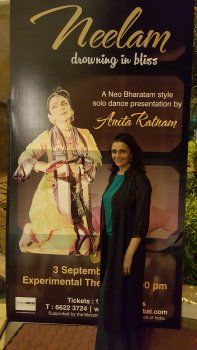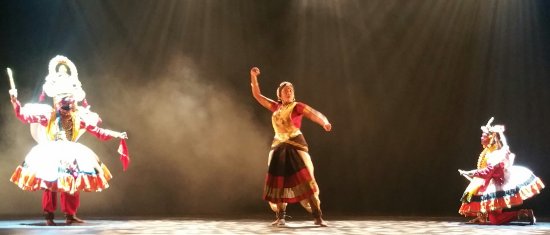
|   |

|   |
October 1, 2015  A breathless month, filled with so many viewings of dance and theatre. Thirty days of almost nonstop watching and also performing, teaching and listening. So far, this has been my stellar 4 weeks of the year - as a rasika, an artiste and a dance explorer. So here goes... September began with a moving and sentimental tribute to the Sanskritist and scholar sans pareil, S. Sarada of Kalakshetra. It was a beautiful and heartfelt evening of dance, speeches and gently nudged memories through scenes from iconic Kalakshetra productions. When the four stalwarts, VP Dhananjayan, CV Chandrasekhar, Balagopal and Janardhanan entered the stage to share the collective responsibility for the varnam ROOPAMU JOOCHI, the audience burst into a spontaneous applause. When VPD and wife Shanta posed as Rama and Sita for the final Tillana/Daru scene, it made many senior alumni wipe their eyes in nostalgia. The packed Rukmini Arangam was heartfelt in its standing ovation to the confluence of experience and art. I did, surprisingly, fall in love with the elegant and intelligent framing of the ‘teernamans’ and ‘sancharis’ of ROOPAMU JOOCHI, forgetting how this one ‘varnam’ almost damaged my knees and lower back with Sarada Hoffman's insistence on deep, deeper, deepest ‘araimandi’ and strong footwork. Today, this varnam represents the essence of Rukmini Devi's vision of modern Bharatanatyam as well as the gender neutral choreography that has become the global signifier of "clean technique." A memorable evening. S Sarada centenary tribute at Kalakshetra I missed the memorial to guru Narasimhachari a few days later which was also very well attended. The passing of another creative spirit, along with a host of invaluable seniors over the past 9 months has surely diminished the creative landscape of dance and music. Perhaps it is now time to do a special issue marking the contributions of these creative dance and music makers. A volume of 100 names who have revolutionized the tapestry of modern Indian dance in the 20th century. I use the word ‘modern’ consciously. We tend to forget that classical dance, as we know it today, is really a modern form - reconstituted for the urban elite post India’s independence and made attractive for larger consumption. It is a far cry from the art of the "sadir" and the artistes that made dance and music their entire life!  NEELAM’s 50th showing at the NCPA in Mumbai was another important milestone. Created from a single long composition of Muthuswami Dikshitar's "Ranga Pura Vihara" in 2005 - the music re-imagined by pianist Anil Srinivasan and beautifully vocalized by Sikkil Gurucharan, NEELAM expanded to include 4 signature pieces that communicated to audiences in several Indian cities and smaller towns. With dynamic choreographic ideas from Hari Krishnan and a path breaking costume design by Rex, the Mumbai event was framed by the professional and smooth handling of NCPA's Swapnokalpa, Benaifer and their team. I received flattering media attention and glowing previews as I landed in "maximum city." Deepa Dharmadhikari's new light design and her placement of flautist G. Raghuraman high above in the rafters was a masterstroke. The packed hall with many South Indians created a warm feeling and a certain "buy in" for the evening. With all the many years of great photos, previews and mostly positive reviews of the work, it is easy to get complacent and smug about one's art and the response it MUST or SHOULD generate. The danger of social media with the deluge of images and forced applause generated by friends and fans can blur objectivity and critical inquiry of the work as it matures and changes with each year. Amidst the many voices of praise, it is very important to pay attention to the lone voice of dissent or criticism if it comes from a senior or respected observer. A note to all senior and junior dancers who are mostly content to manufacture consent. Step back and listen now and then. You may not like what you hear but it provides a check point for introspection. Prickly dancers and vanishing criticism was among the topics of discussion with senior critic Leela Venkataraman during our week long stay in Kuala Lumpur. Invited by Ramli Ibrahim to attend and respond on our respective media outlets on the ambitious month long DIVERSECITY Arts Festival, we found ourselves thrown into the delicious whirlwind of daily rehearsals, late dinners and multiple shows. What a treat! A friendly city, whose national obsession is food, fun, entertainment and BLING. Excellent theatres, efficient stage management and technical staff, good seats and warm citizens. Art from Vietnam, Azerbejan, Myanmar, India, Pakistan and, of course, Malaysia. Leela Venkataraman and Ramli Ibrahim
Ramli was the artistic director of the dance component of the festival that included, music, traditional theatre, standup comedy, food and cinema. With the strong Tamil connection in Malaysia, Ramli had boldly curated several new evenings of folk, contemporary and neo classical work based on Bharatanatyam and South Indian folk traditions. Many were world premieres and most were above average, with some being excellent. On the day I landed, Malaysian, Taiwanese and American artistes collaborated in a music and dance event called PATH OF DISCOVERY, where Ramli shone in his contemporary avatar. Wearing a long white skirt, his fluid body skimmed across the stage and glided with balletic ease. The very next day, Chennai's folklorist V.R. Devika unveiled her large canvas of folk theatre through SIRIYAMMA SIRI - LAUGH GODDESS LAUGH. My detailed observations about these and other shows at DIVERSECITY can be accessed through my blog. ANITA RUNS AMOK in which I have described the shows and other aspects of the performances I viewed.  SIRIYAMMA SIRI - LAUGH GODDESS LAUGH What I would like to add here is that the level of professionalism I saw in Kuala Lumpur in terms of infrastructure for the arts is very impressive. In the heat of public protests against the ruling government, daily life continued, although attendance for some shows was disappointing. Presenters and organizers are facing the common challenge of getting bums on seats. The Hip Hop show PAK PANDIR YO showcased in the huge national ISTANA BUDAYA theatre attracted the young Malaysian crowd who turned up in good numbers to hoot, whistle and applaud the talented ensemble. Ganjam ; Photo: A Prathap Ramli himself was running himself ragged supervising so many new productions that he has selected while rehearsing for his own magnificent evening called GANJAM. Titled after the southern Odisha district bordering Andhra Pradesh (or is now Telengana?) the art of GANJAM shows a distinct South Indian flavour in painting and music. The reconstruction of modern Odissi left out this aspect of Odisha art and centred all around the area of Puri. Allegedly a remark by Rukmini Devi of Kalakshetra hurt the sentiments of the Odisha artistes in the 1960s. She is supposed to have watched Odissi and commented that it was "patchwork Bharatanatyam!" The great Sanjukta Panigrahi hailed from Ganjam district and studied at Kalakshetra first before immersing herself in her native form. Attending rehearsals is more rewarding than watching a finished performance. I was able to observe the contemporary dance ensemble of DUA SPACE in a suburb of KL. The two founders of this Malaysian company, Aman Yep and Anthony Meh, have worked at Cloud Gate Theatre in Taiwan and have brought their fluid Asian inspired dance designs back to their home town. This duo has collaborated with costume, lighting, sets and were in the final days of interacting with technology and a giant touch screen as a set design! I was not able to watch the performance but the aesthetic was compelling and Malaysian audiences will be immersed in a sensorial and immersive experience! GEMA SILAPIN was a example of how a university performing arts department - UPSI - could fine tune and rehearse an excellent evening of Zapin (Malay folk dance), Silat (Malay martial art) and Gammelan (music). The final piece, although soaked in Islamic colours and mood, was a superbly synchronized offering of movement and music. While the first half of the evening showed the Malay women practicing Silat with agile ease, they appeared demure, with head covered in the final segment, in keeping with the current wave of conservatism sweeping Malaysia. Still, it was a memorable evening as to what a good choreographer - Abdul Hamid Chan - and a cooperative performing arts department can create. In conversation with festival PR expert Mala Chandran, I realized that KL is also afflicted with the STAR SYNDROME. Get a royal (Malays love their royals!) or a pop star and you are guaranteed a crowd and media attention! The economics of the festival was also interesting. Ramli had set it up so that many of the selected companies would be showcased in professional mainstream theatres for the very first time and they would share a large percentage of the box office. So that motivated them to do their own PR and publicity to help sell tickets. Aaah, yes... tickets! I did see a lot of tickets being sold and a smaller portion of freebies at the festival. At 30 to 50 ringgits a pop (450 to 750 rupees) it is a good sign that people are ready to pay. GANJAM was sold out for all its five days but then Ramli is a national icon, his remarkable story appearing in school text books! Hema Nandini
Performer/activist Sangeeta Iswaran has found her niche as a compelling actor and story teller. She needs a dramaturg to transform her experiences in conflict ridden areas into art. An enormous talent, her presence was strong and mostly convincing in both evenings she participated in. Hema Nandini, a local Malaysian Tamil Bharatanatyam dancer, rose to the occasion and redeemed Ramli's faith in her natural home grown talent in her solo evening titled ANURAG. Accompanied by a superb orchestra led by K J Sarasa's student Shanmugam and vocalist Preethi Mahesh, the evening proved how crucial high quality music is to a classical performance. Shankar Kandaswamy's NEO MARGAM, although afflicted with a problematic title, shows real potential. He should change the title to OFF BALANCE. That way he can steer clear of any hint of appropriation, misappropriation and so on. NEO MARGAM, an ensemble work, is worth watching and polishing for touring purposes. A work that Bharatanatyam dancers MUST see to believe how cross disciplinary training can make a classical body more articulate! Speaking of music, the Spanish singers who accompanied Akram Khan and Israel Galvan in TOROBAKA were superb. SUPERB. No other word to describe this quartet of musicians who also assumed the spotlight as performers. I have seen some other attempts at Kathak and Flamenco collaborations, but in the hands of these two masterful men, the work transformed into machismo magic. TOROBAKA was a duel like symphony of dance, theatre, silence, sharp lunges and gentle curves. Shiva, Krishna images were fleetingly suggested as were the bull and the matador. The Chennai audience was gasping at each of the solos and duets by Akram and Israel. A giant bull pen as circular lighting and a fierce confrontational style of improvisation - each dancer being able to playfully and skillfully weave in and out of their respective disciplines was a delight to watch. Choreography that was created as solid and yet danced with liquid ease, the proscenium stage transformed into a site specific space, gravity and floor work executed with precision and danced with ferocious intensity made for a magnificent experience. The percussionist, who uttered the Kathak bols and konnakkol with faultless diction, also played the drums and ganjira with élan. The musical map of ancient shared histories and the level of skill and invention on stage masked some of the awkward moments from what is a far from perfect work. TOROBAKA - The bull and the cow! Oh what an evening of brilliant dancing and music! Indian classical musicians… please note and take a cue as to how to transform your art into theatre! I am particularly proud of the Chennai audiences. They have grown significantly for alternate work and also want to support it generously by donating money at the end. IF REQUESTED. During the two day event performed by ADISHAKTI actors of Auroville at SPACES, Chennai, the 200 strong crowd donated various amounts to show their support for contemporary theatre and as a sign that they are present and ready to support fresh energies in the live arts. Way to go! And here is a shout out to Sadanand Menon who has transformed Chandralekha's residence into the most exciting creative space in Chennai. Protestors, activists, theatre, dance, sadir, music, painting, film, poetry and more are filling this space almost daily! Chandralekha, the symbol of protest for many feminists, will surely be smiling! Not all is good news. With the December art season approaching, some sabha auditoriums in Chennai have raised their prices and also refused to open their doors before 5pm. All this for a 6pm start time! Really! How does one even BEGIN to consider professional presentations? Add to this the confusion of parking spaces and traffic gridlock, attendance in some halls will come down this season. But the canteens will always be full! Time to consider private spaces with smaller audiences so each show can have a longer run. Fresh controversies seem to be erupting about the national cultural institutions. Kalakshetra is once again on the front pages of New Delhi papers about problems that have more questions than answers, and the central art AKADEMIS are struggling with the changing winds of support from the present government. With our Prime Minister having wowed Silicon Valley and promising to DIGITIZE INDIA, we in the world of dance must remind ourselves that the dancer is the ultimate convergence of technology. Physics, chemistry, botany and alchemy... all culminate in this fascinating machine called the DANCING BODY. Why are we not celebrating this more and shouting about this good news? Instead, we stay cooped up in our snug cubby holes and pretend that "ALL IS WELL." Look around us, things are a changing. And in India, dance is not part of that change. Education may be the next big thing but who are the teachers? If everyone wants to be on stage, then who will nurture and shape Gen Next who may not continue to dance but may emerge as a more sensitive human being? With this portal soon entering its 17th year, I am noticing more dance companies bringing out individual newsletters .The latest is Kolkata's RHYTHMOSAIC, with flamboyant Oindrilla Dutt as its editor. Welcome to the digital space, Ronnie and Mitul Sengupta. Also, PULSE from the UK has broadened its vision to include high quality writing from around the globe. Reviews are succinct and intelligently worded, making me realize that there ARE minds out there that are ready to speak and write about dance. Congrats, Sanjeevini. Well done in your pursuit of raising the footprint and quality of your magazine! Now to find the time to READ all that is out there in cyberspace! for SANANDA, OCTOBER PUJA SPECIAL ISSUE
With the festival season upon us, I am hugely flattered to be the featured model in the prestigious feminist magazine of Bengal SANANDA. Shot over four hours in a small and sultry Kolkatta studio, the magic of styling by editor Sharmila Basu Thakur and designer Paromita Bannerjee, combined with the expert eye of photographer Swarup Dutta made me look so different and glamorous in the 9 looks of Devi Durga. I felt like a Tagore Thakurani! Am sharing these 9 images with the readers and hope that the Navaratri/Puja season brings you joy, cheer and a remembrance of all that is dear to your hearts. Enjoy, Explore, Enchant, Electrify, Enthrall, Enthuse, Excite, Exude, Endear My nine wishes for all of you. And much, much more... Anita R Ratnam Chennai/ Kolkata/ Kancheepuram/ Mumbai PS: While NAMO is busy raising the tech and digital possibilities of India and encouraging Garba festivals and Gujarat Expos everywhere, he does not realize that two Gujjus are making dance history. Aditi Mangaldas and Aakash Odedra are collaborating on a new solo called ECHOES, inspired by the Ghunghroos. And that India's classical dance and music traditions have long since been effective REVERSE colonizers in the UK and the USA. Twitter: @aratnam Facebook: Anita R Ratnam Instagram: @anitaratnam Blog: THE A LIST / anita-ratnam.blogspot.in Post your comments |